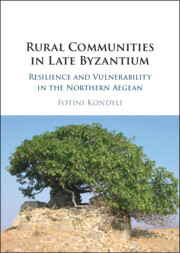Book contents
- Rural Communities in Late Byzantium
- Rural Communities in Late Byzantium
- Copyright page
- Dedication
- Contents
- Preface
- 1 In Search of Late Byzantine Rural Island Communities
- 2 Who’s Who in the Rural Landscape
- 3 Pathways of Resilience
- 4 Defending the Realm
- 5 Community-Building in the Face of Crisis
- 6 The Return of the People
- Book part
- References
- Index
3 - Pathways of Resilience
Published online by Cambridge University Press: 24 February 2022
- Rural Communities in Late Byzantium
- Rural Communities in Late Byzantium
- Copyright page
- Dedication
- Contents
- Preface
- 1 In Search of Late Byzantine Rural Island Communities
- 2 Who’s Who in the Rural Landscape
- 3 Pathways of Resilience
- 4 Defending the Realm
- 5 Community-Building in the Face of Crisis
- 6 The Return of the People
- Book part
- References
- Index
Summary
The crises of the Late Byzantine period were complex and multifaceted; they included episodes that resulted in gradual change as well as sudden events that triggered immediate and unforeseen effects. A steady population increase until the thirteenth century had contributed to soil degradation and the exhaustion of resources as well as to the rise of economic and political superstructures (i.e., the landed nobility and monasteries). The efforts of revival and restoration of the empire in the aftermath of the Fourth Crusade and the ongoing political and military conflicts with new rising powers such as the Serbian Kingdom and the Ottomans further contributed to the strain of resources. Environmental changes in the fourteenth century, which included cooler temperatures and an increase of rainfall, also affected rural communities throughout Europe and could be catastrophic for some types of agriculture, including viticulture and olive cultivation.1 Such phenomena made societies even more vulnerable to the demographic and economic crisis caused by the sudden arrival of the Black Death.
- Type
- Chapter
- Information
- Rural Communities in Late ByzantiumResilience and Vulnerability in the Northern Aegean, pp. 73 - 132Publisher: Cambridge University PressPrint publication year: 2022



